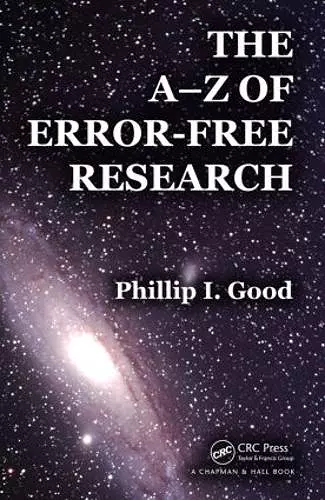The A-Z of Error-Free Research
Format:Paperback
Publisher:Taylor & Francis Inc
Published:1st Aug '12
Currently unavailable, and unfortunately no date known when it will be back
This paperback is available in another edition too:
- Hardback£145.00(9781138381742)

A Practical Guide with Step-by-Step Explanations, Numerous Worked Examples, and R CodeThe A–Z of Error-Free Research describes the design, analysis, modeling, and reporting of experiments, clinical trials, and surveys. The book shows you when to use statistics, the best ways to cope with variation, and how to design an experiment, determine optimal sample size, and collect useable data. It also helps you choose the best statistical procedures for your application and takes you step by step through model development and reporting results for publication.
Transition from Student to ResearcherHelping you become a confident researcher, the book begins with an overview of when—and when not—to use statistics. It guides you through the planning and data collection phases and presents various data analysis techniques, including methods for sample size determination. The author then covers techniques for developing models that provide a basis for future research. He also discusses reporting techniques to ensure your research efforts get the proper credit. The book concludes with case-control and cohort studies.
"… this primer on research design helps shed light on some of the fundamental issues in experimental design, analysis, and dissemination of results. Some of the most effective chapters are those regarding logistics and planning, how one should think about data and variation, how best to present results, and even how to respond to rejection. The author assumes some basic knowledge of mathematical statistics and the R programming language, and for readers with a solid research methods background, this primer will be a useful addition to their toolbox."
—Jo A. Wick, The American Statistician, November 2014
"This book is a general primer, with examples, explaining the value of statistical design and analysis of experiments. It uses the R computing language for all illustrative calculations and is written in a plain, down-to-earth, and easily understood manner."
—International Statistical Review, 2013
"Making the transition from student to professional researcher can be a daunting experience. This book can serve as a valuable refresher on hypothesis testing, coping with variation, data collection, sample size decisions and more, along with cursory explanation of R output largely based on freely available data sets. … This is high-level material to aid the reader in becoming a confident researcher … . For the reader who wants to put theory to practice, and do it in R, this work can be a guide to success in analyzing and collection categorical data, detecting confounding, bootstrap approaches, case-control and cohort studies, and more."
—Tom Schulte, MAA Reviews, April 2013
"… a nice primer for academic researchers. The book includes practical and straightforward information, if you like your statistics moderately seasoned with formulae and althorithms."
—Journal of Clinical Research Best Practices, June 2013
"… this primer on research design helps shed light on some of the fundamental issues in experimental design, analysis, and dissemination of results. Some of the most effective chapters are those regarding logistics and planning, how one should think about data and variation, how best to present results, and even how to respond to rejection. The author assumes some basic knowledge of mathematical statistics and the R programming language, and for readers with a solid research methods background, this primer will be a useful addition to their toolbox."
—Jo A. Wick, The American Statistician, November 2014
"This book is a general primer, with examples, explaining the value of statistical design and analysis of experiments. It uses the R computing language for all illustrative calculations and is written in a plain, down-to-earth, and easily understood manner."
—International Statistical Review, 2013
"Making the transition from student to professional researcher can be a daunting experience. This book can serve as a valuable refresher on hypothesis testing, coping with variation, data collection, sample size decisions and more, along with cursory explanation of R output largely based on freely available data sets. … This is high-level material to aid the reader in becoming a confident researcher … . For the reader who wants to put theory to practice, and do it in R, this work can be a guide to success in analyzing and collection categorical data, detecting confounding, bootstrap approaches, case-control and cohort studies, and more."
—Tom Schulte, MAA Reviews, April 2013
"… a nice primer for academic researchers. The book includes practical and straightforward information, if you like your statistics moderately seasoned with formulae and althorithms."
—Journal of Clinical Research Best Practices, June 2013
ISBN: 9781439897379
Dimensions: unknown
Weight: 385g
269 pages